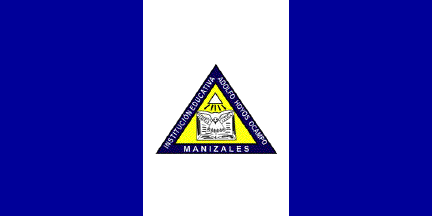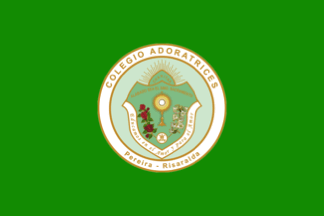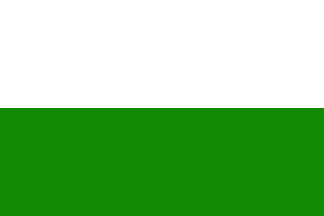 klaus-michael schneider
klaus-michael schneider
Keywords: education |
Links: FOTW homepage | search | disclaimer and copyright | write us | mirrors

FOTW beschäftigt sich mit der Wissenschaft der Vexillologie (Flaggenkunde).
Alle auf dieser Website dargebotenen Abbildungen dienen ausschließlich der Informationsvermittlung im Sinne der Flaggenkunde.
Wir distanziert uns ausdrücklich von allen hierauf dargestellten Symbolen verfassungsfeindlicher Organisationen.
Last modified: 2021-08-26 by  klaus-michael schneider
klaus-michael schneider
Keywords: education |
Links: FOTW homepage |
search |
disclaimer and copyright |
write us |
mirrors
See also:
Other Institutions:
 image by Ivan Sache, 02 December 2014
image by Ivan Sache, 02 December 2014
Academia Francia Belleza y Diseño Cauca, located in Popayan (Cauca Department)
educates manicurists, podiatrists, hairdressers and make-up artists and
designers.
The flag of the institute is horizontally divided white-green. A white triangle
is placed along the hoist, limited on its left by a magenta border and charged
with the institute's emblem.
The emblem of the institute was adopted by Agreement No. 1 of 15 March 2014,
according to the norms established in the institute's Etiquette Guidebook and
Corporative Visual Identity Guidebook. The shield is of "metallic texture". The
gray bordure is inscribed with three words found in the Book of Proverbs, "CIENCIA
SABIDURIA" (Science, Learning; left) and "CONOCIMIENTO" (Knowledge; right). The
shield is vertically divided by wavy lines into three parts:
- the left part features on a magenta background a white pair of scissors
representing the techniques and trends of decorative aesthetics:
- the right part features on a green background a hairdresser's comb,
representing clearness and care in beauty;
- the central part features on a white background a composite element shaped
like a woman's silhouette, made of the Eiffel Tower, representing the first logo
of the institute and France ("Francia") superimposed with a woman wearing an
elegant sombrero, clad in white and outlined in magenta, representing subtlety,
elegance, glamour and beauty. Beneath the silhouette is an open book,
superimposed with two hands supporting the woman-shaped silhouette, meaning that
the institute is placed in God's hands.
The shield is surrounded by four scrolls attached to two staffs in the upper
part, meaning command, safety and strength. In the lower part is a golden yellow
plaque inscribed with "2005", the year of foundation of the institute as
Institución Educativa para el Trabajo y el Desarrollo Humano. The two scrolls
closer to the shield are green, while the two distant ones are magenta,
inscribed with the institute's motto "ESFUERZATE Y SE VALIENTE" (Work and Be
Valiant). The shield is surmounted by a white scroll inscribed with the
institute's name in black capital letters.
Apple green, white and magenta are the corporate colours of the institute.
Green represents life, natural environment, growth, health, renovation, rest,
fertility, resistance, freshness, elation, calm, balance, harmony, hope, youth,
lightness, confidence, stability and economy.
White, as the colour of the Holy Ghost, represents purity, virginity, perfection
and limpidity. Associated with light, kindness, innocence and freshness, it
represents faith.
Magenta represents compassion, support, kindness, glamour, elegance, maturity,
benignity, grace, sincerity, amiability, enthusiasm, understanding, abnegation
and empowerment.
Source:
http://academiafrancia.com/nosotros/simbolos-institucionales - Institute's
website
Ivan Sache, 02 December 2014
A while ago in May I spotted the ESAP flag shown on TV during
the ceremonies for their 50th anniversary.
The ESAP (Escuela Superior de Administración Pública, Public
Administration Superior School) was established by Law 19 of
November 25, 1958 and traces its origins as a response to
several missions to the country made earlier, but mainly during
the regime of General Gustavo Rojas Pinilla (1953-1957), among
them a commission from the French Government (n.d), The Kemmerer
mission (led by prestigious Economist Edwin Walter Kemmerer which
lasted several years and went to several countries, and visited
Colombia in 1923 to help establish the Central Bank, today known
as Banco de la República) the World Bank Mission in 1949 led by
Professor Kerry, The Louchlin Currier mission (led by
Canadian-born Economist, later U.S. naturalized citizen and then
Colombian citizen after the U.S. denied to renew his passport
Lauchlin Bernard Currie between 1949 and 1953), and
also private foundations such as the Ford and Kellogg
Foundations), in which some of their recommendations were to
modernize the Colombian State Organization.
The ESAP is a Public University under the DAFP and helps in administrative
tasks to educate people who are to work in the civil service.
It currently operates several branches around to cover the whole
country as follows:
- Antioquia – Chocó (located in Medellín)
- Atlántico, Magdalena, Cesar and Guajira (located in Barranquilla)
- Bolívar, Sucre, Córdoba and San Andrés Islas. (located in Cartagena)
- Boyacá and Casanare (located in Tunja)
- Caldas (located in Manizales)
- Cauca (located in Popayán)
- Cundinamarca (located in Fusagasuga)
- Huila and Caquetá (located in Neiva)
- Meta, Guaviare, Guainia, Vaupés, Vichada, Amazonas (located in
Villavicencio)
- Nariño, Putumayo (located in Pasto)
- Norte de Santander – Arauca (located in Cucuta)
- Risaralda – Quindío (located in Dosquebradas)
- Santander (located in Bucaramanga)
- Tolima (located in Ibagué)
- Valle (located in Cali
The flag is the ESAP logo on a white background.
Sources: ESAP official
website, Spanish wikipedia.
E.R., 16 June 2009
 image by Ivan Sache, 22 July 2014
image by Ivan Sache, 22 July 2014
Institución Educativa Adolfo Hoyos Ocampo is located in Manizales (Caldas
Department). The institute is named for Father Adolfo Hoyos Ocampo (1882-1970),
considered as a benefactor of Manizales. President of the Society for Public
Improvement, the priest pushed the building of the roads to Chinchiná and
Termales, of the Nubia airport, of the Palace of Fine Arts, of the Caldas cement
factory, of the Faculty of Medicine of the Caldas University and of the Faculty
of Engineering of the National University.
The flag of the institute is
vertically divided blue-white-blue with the institute's emblem in the middle.
Blue is a symbol of the depth of ideas and of the Blessed Virgin, a model of
virtues and values. White is a symbol of transparency, peace, tolerance, and
purity.
http://caho.edu.co/wordpress/?page_id=35 - Institute's website
The
emblem of the institute is inscribed in a blue equilateral triangle, a symbol of
stability and strength. It features the three pillars of the institute on a
golden background, a symbol of wealth, an open book as an example of study and
knowledge, from which emerges, as a consequence, a dove with spread wings, an
invitation to personal and community peace; all over, the sacred illumination of
the Holy Trinity.
http://caho.edu.co/wordpress/?page_id=34 - Institute's website
Ivan Sache,
22 July 2014
 image by Ivan Sache, 3 January 2021
image by Ivan Sache, 3 January 2021
Colegio Adoratrices is located in Pereira (Risaralda).
The flag of
Colegio Adoratrices is green with the school's emblem.
Green is a symbol of
mystic, inner life and all principles required to increase creative and sensible
skills. Green synthesizes the force of intelligence.
The emblem is
composed of a shield placed on a green background and surrounded by a ring
inscribed with the school's name and location.
The upper part of the shield
is shining like the sun and inscribed with "Charitas" (Charity). Beneath it, the
writing "Alabado sea el Santísimo Sacramento" (Glory to the Blessed Sacrament),
highlighting the monstrance featured in the center and Eucharistic adoration.
The monstrance is surrounded left by a branch of red roses, symbolizing love,
and right by a lily, symbolizing purity and beauty. The two plants are tied by a
Marian monogram.
http://adoratricespereira.edu.co/index.php/simbolos-institucionales
School website
Ivan Sache, 3 January 2021
 image by Ivan Sache, 9 October 2018
image by Ivan Sache, 9 October 2018
Colegio Adventista Libertad (COAL) is located in Bucaramanga (Santander
Department).
The flag of COAL is horizontally divided white-green.
https://colegioadventistalibertad.edu.co/web/emblemas/
COAL website
Ivan Sache, 9
October 2018
 image by Ivan Sache, 9 July 2014
image by Ivan Sache, 9 July 2014Colegio Municipal Aeropuerto was established in 1975 in Cúcuta (Norte del Santander Department), as Escuela Julio Rincón, allegedly named for the leader of a workers' union murdered in Cali. The institute was transferred in 1979 from the Aeropuerto (Airport) borough to the downtown, following a flood, and relocated in 1983 in Aeropuerto. Colegio Municipal de Bachillerato Barrio Aeropuerto was established by Municipal Decree No. 46 of 26 November 1996. Institución Educativa Colegio Municipal Aeropuerto was established in 2003 by the merging of Colegio Municipal de Bachillerato Barrio Aeropuerto, Escuela Integrada Julio Rincón, Escuela Luis Carlos Galán Sarmiento, Colegio Básico Toledo Plata, Colegio Básico Virgilio Barco and Escuela Rural Los Peracos. The college is named for the International Airport Camilo Daza (900,000 passengers in 2012), inaugurated on 10 October 1971.
The flag of
the institute is divided white-wine red by a thin green stripe running from
the lower hoist to the upper fly. White is a symbol of beauty, honour and
transparency. Wine red is a symbol of human touch, affectivity and
cordiality. Green is a symbol of hope.
http://www.colaeropuerto.edu.co/simbolos.html - Institute's website
Ivan Sache, 9 July 2014
Hosted by: Fanshop-Online.de und Handy-Shop.de
Tipp: Apple iPhone 12 im Shop